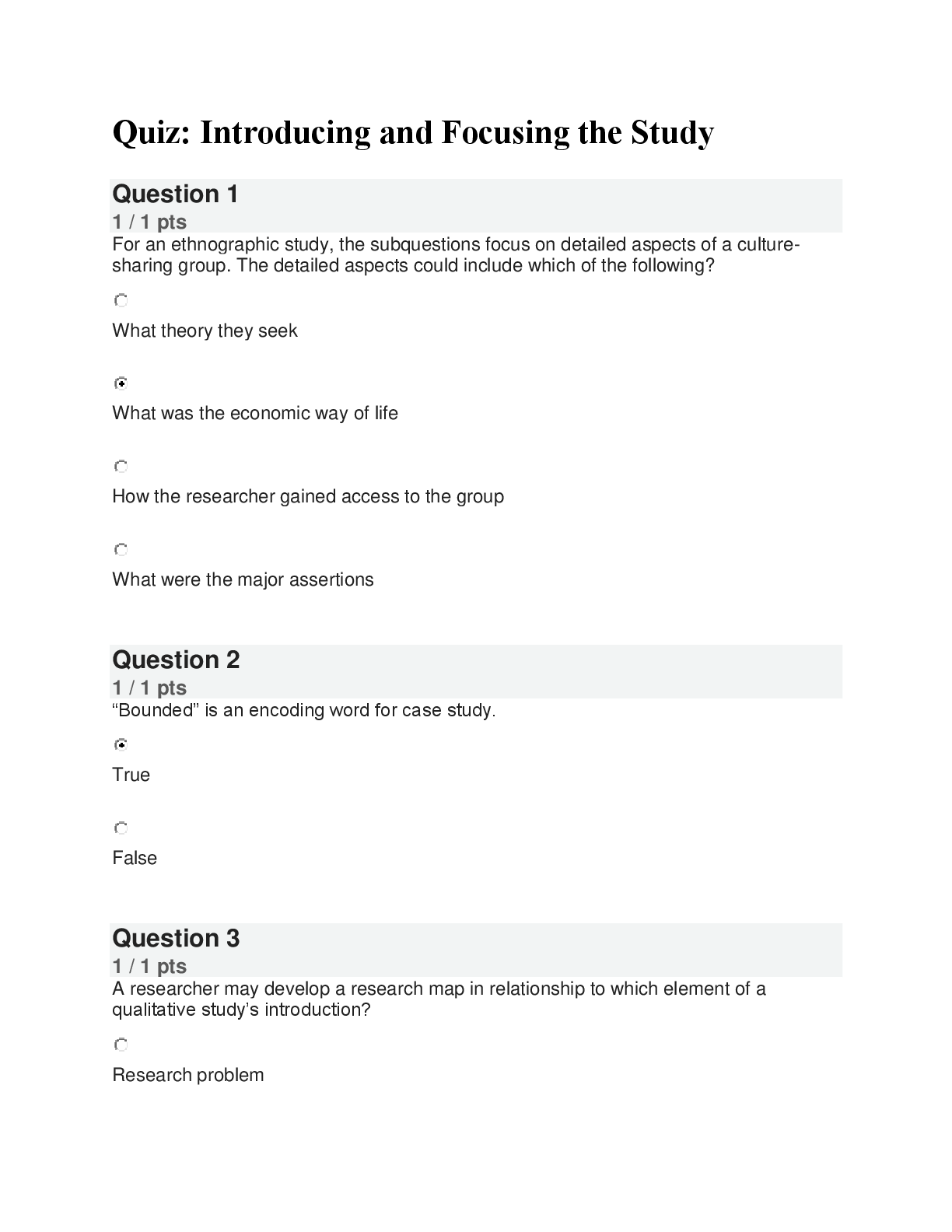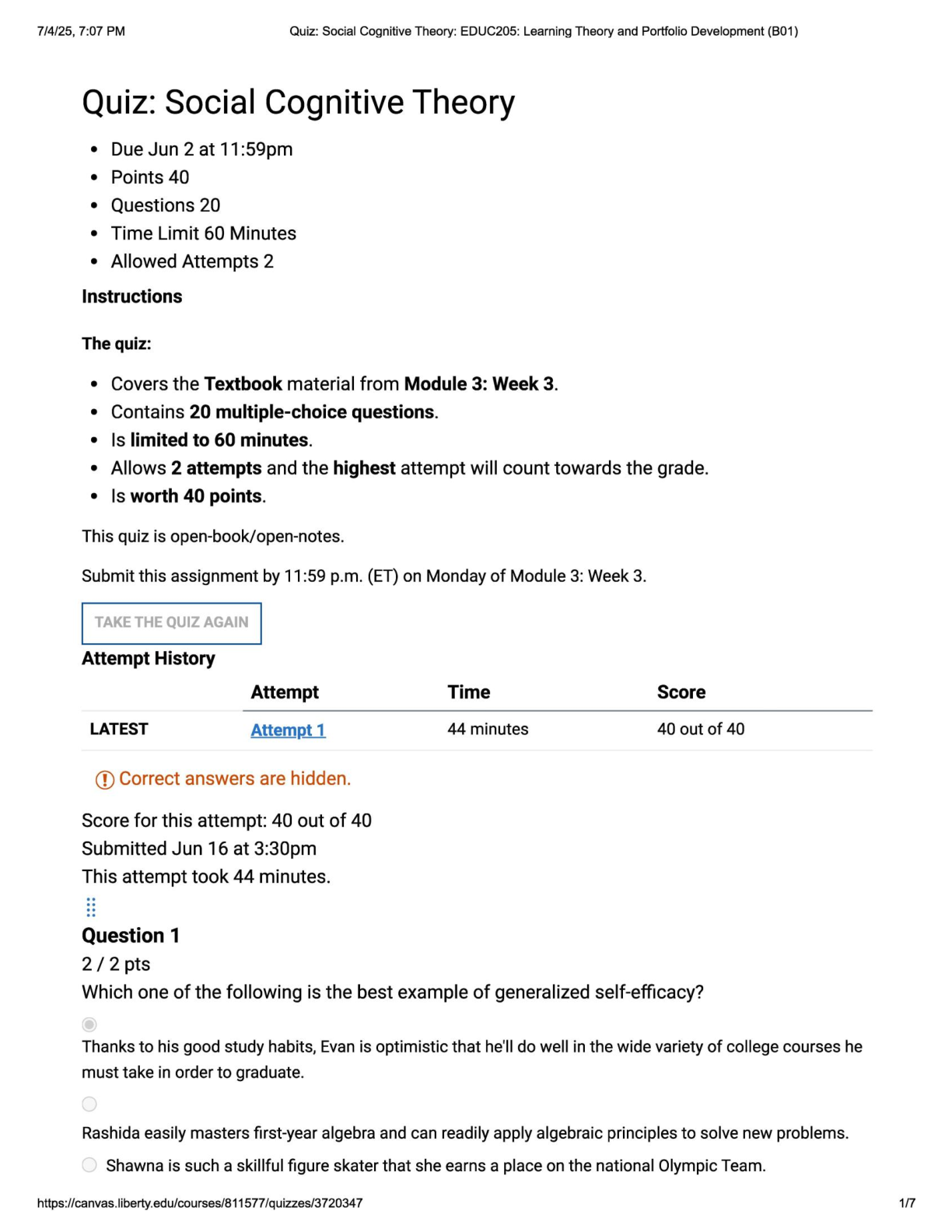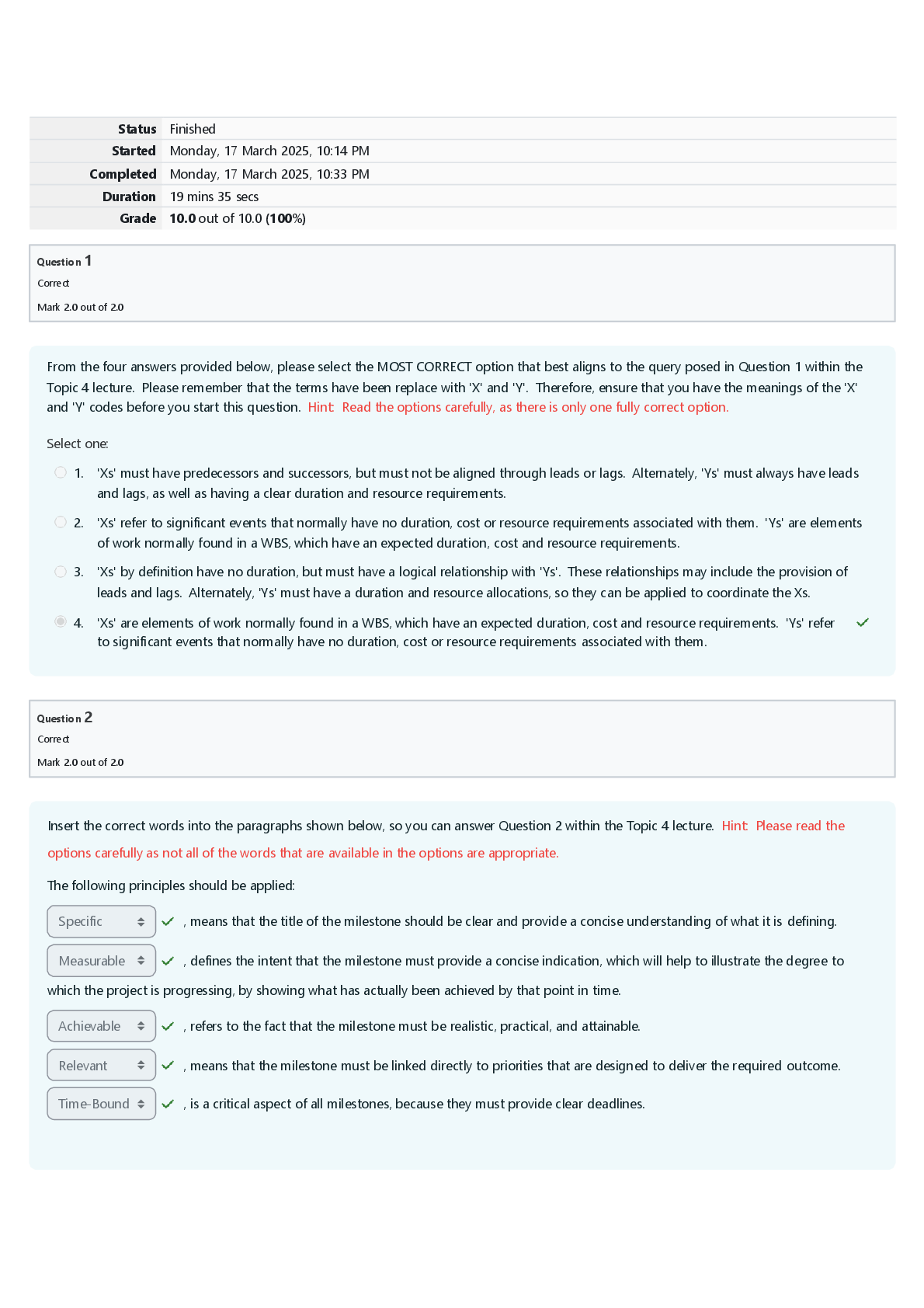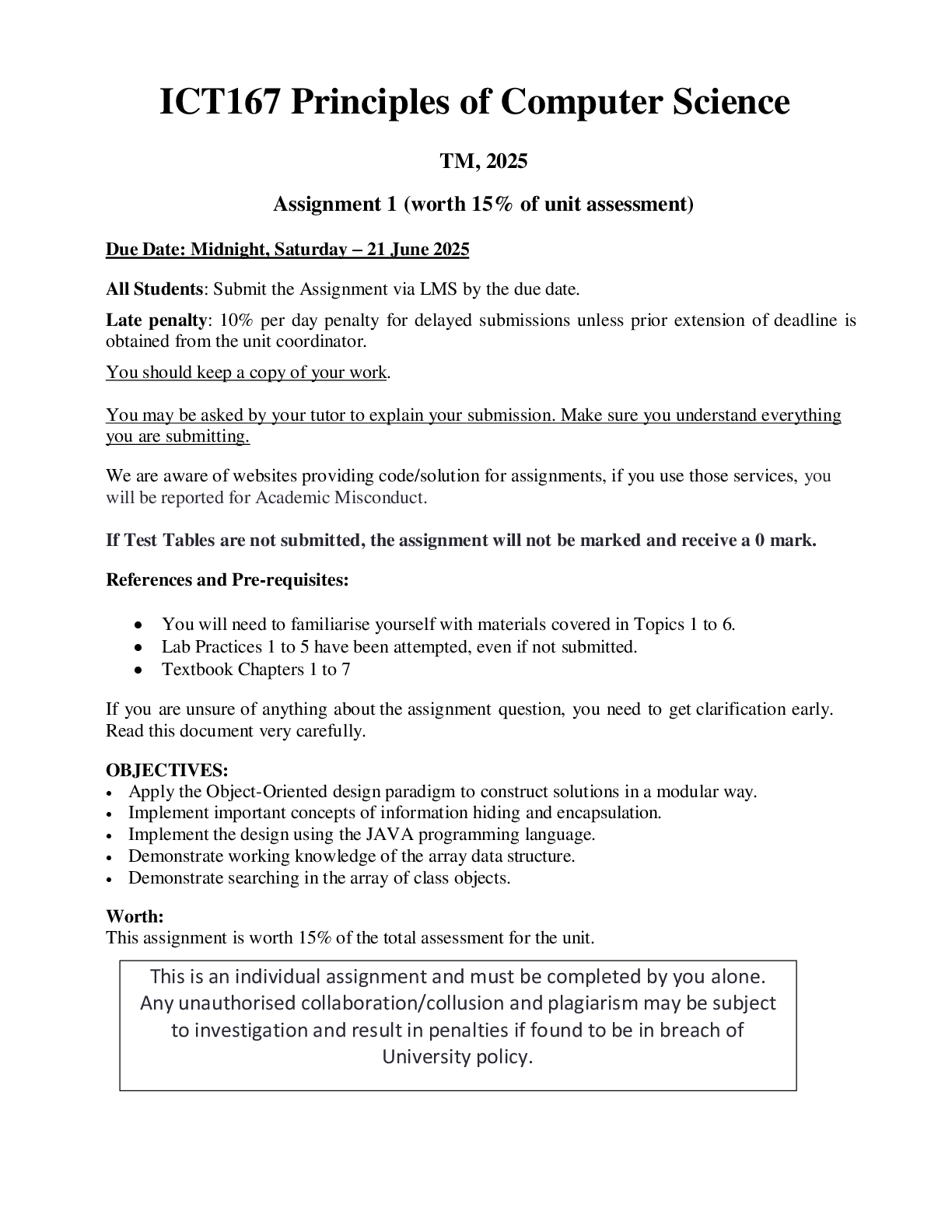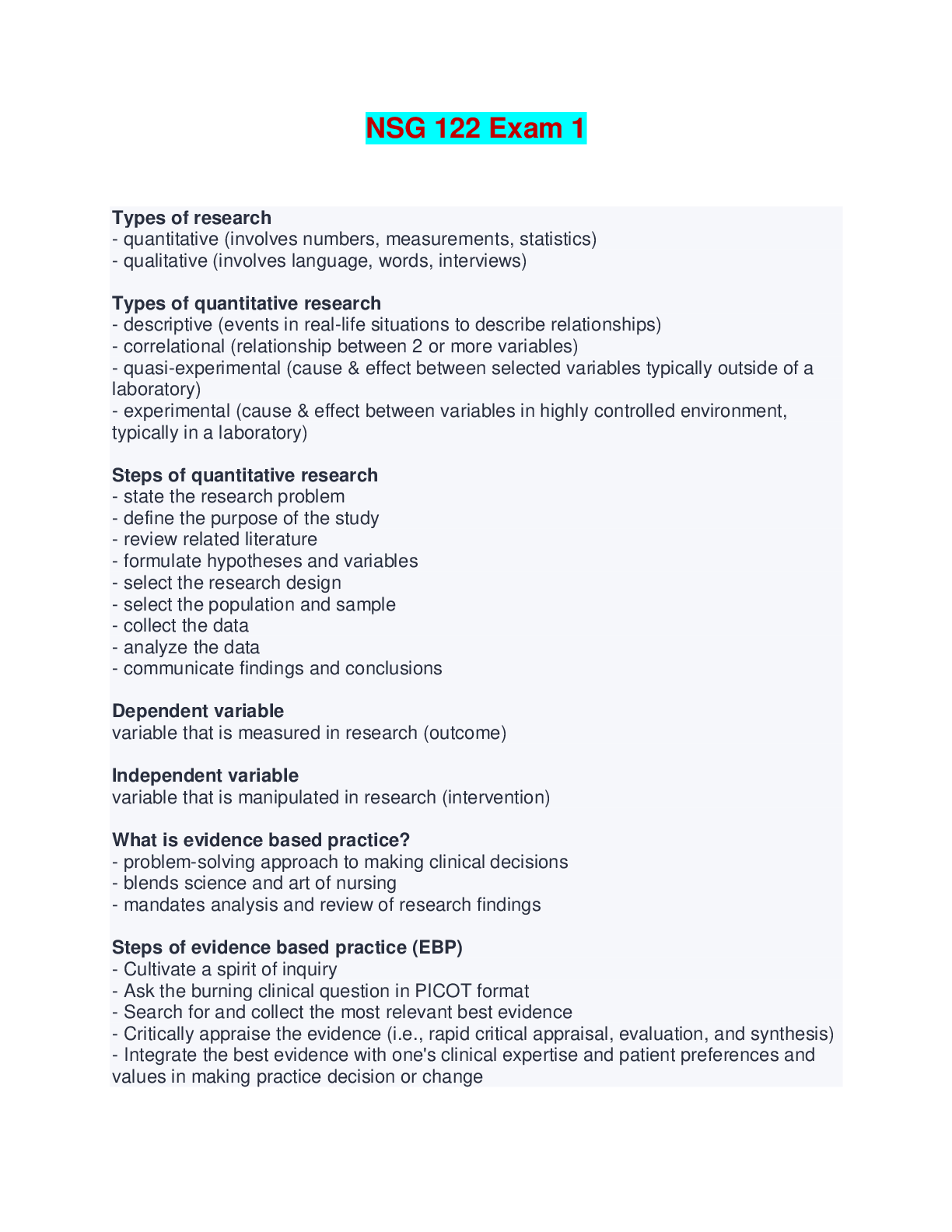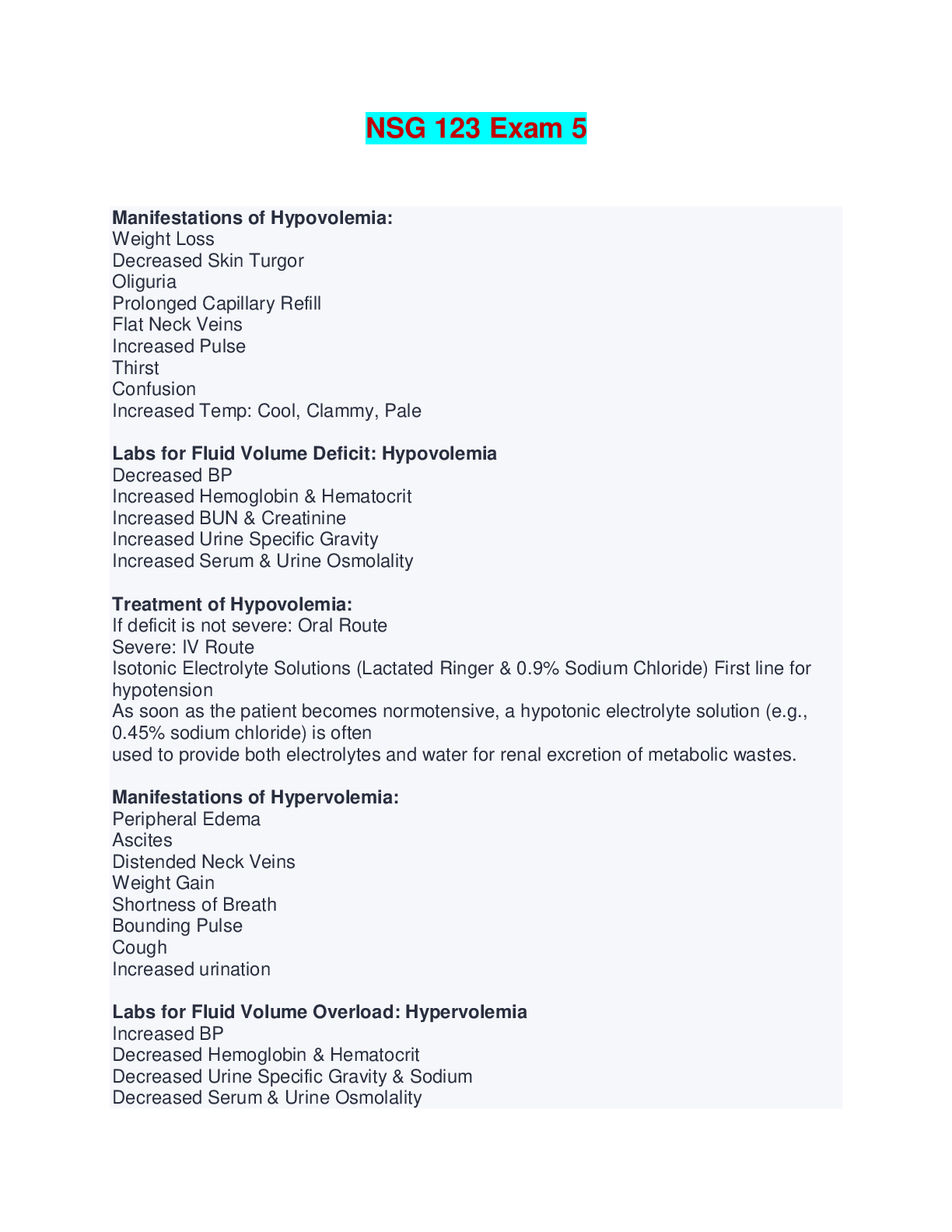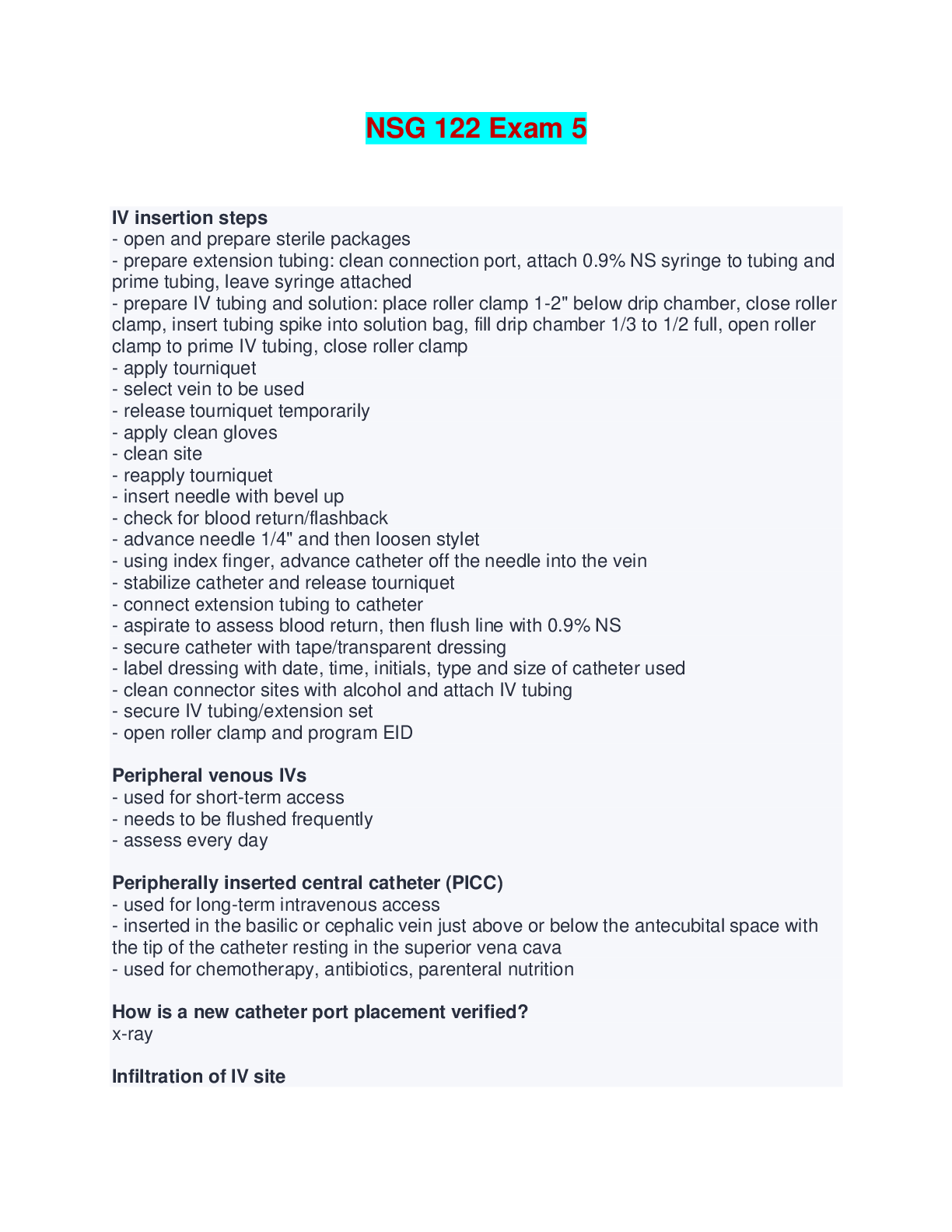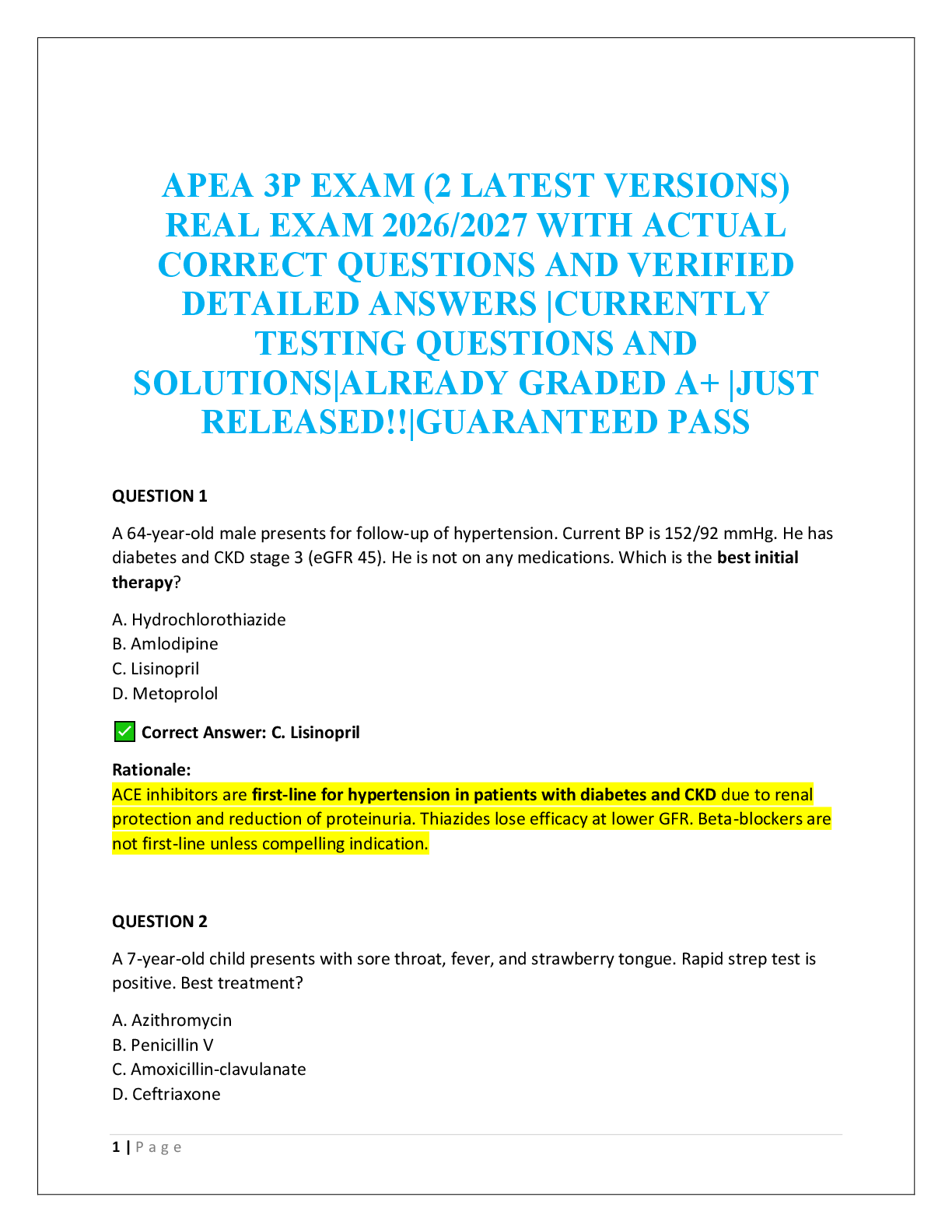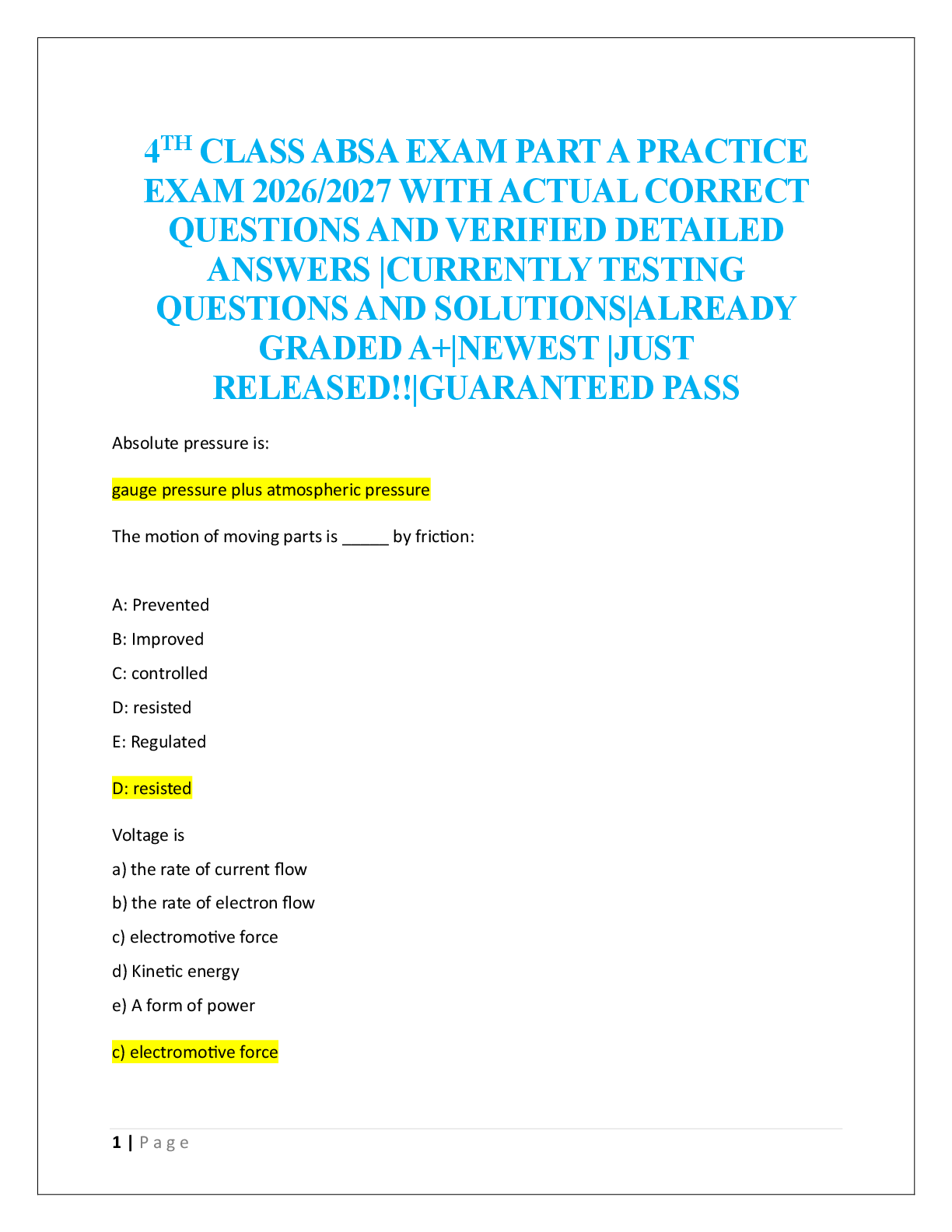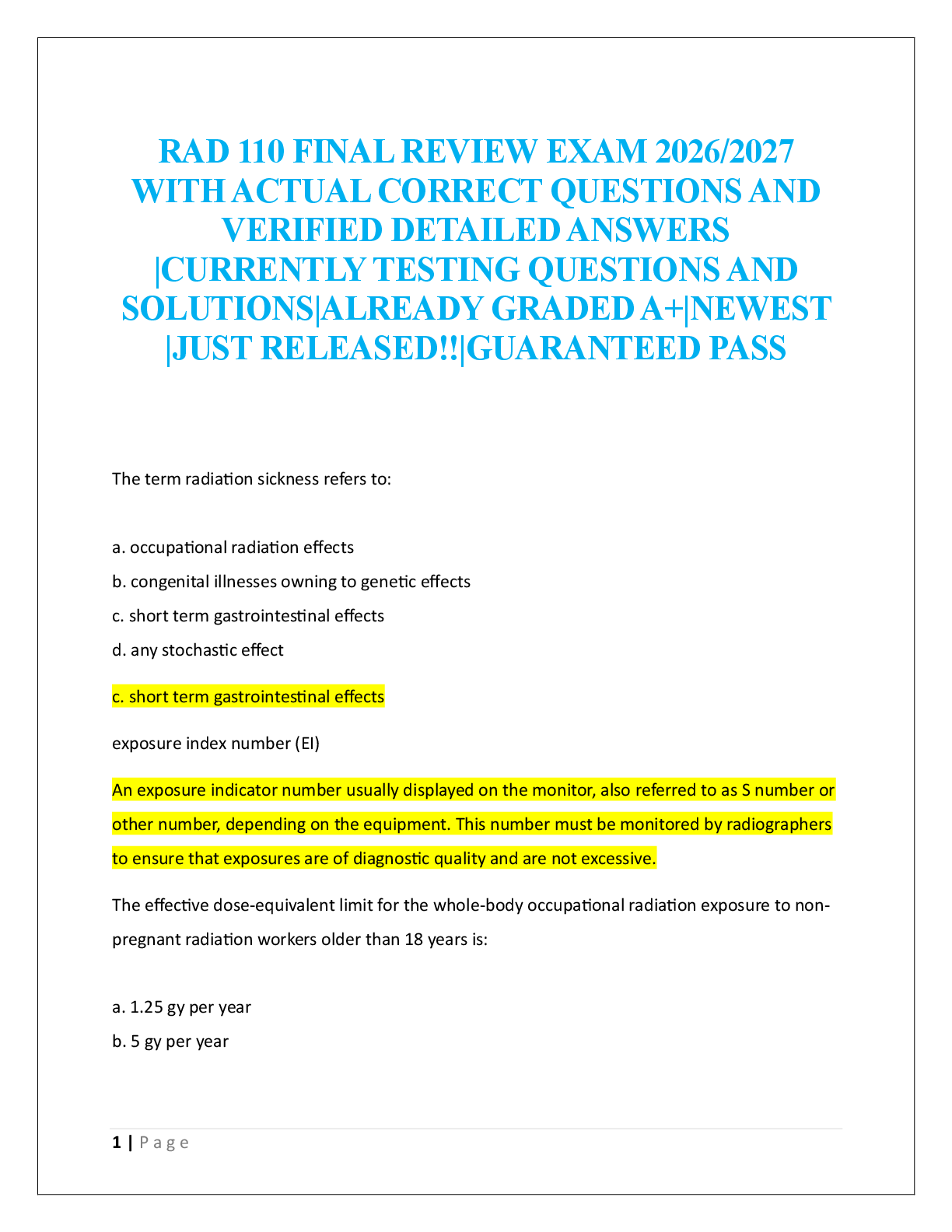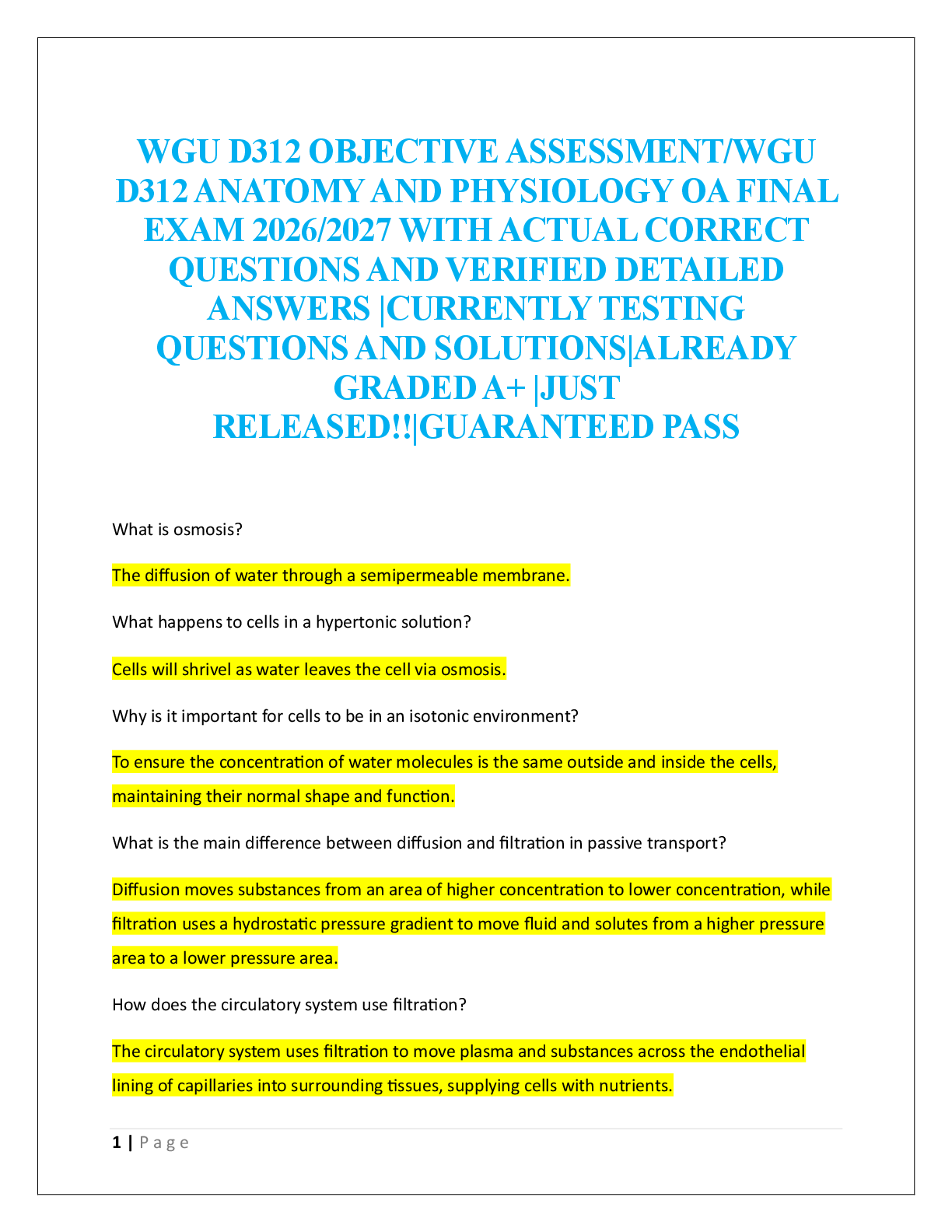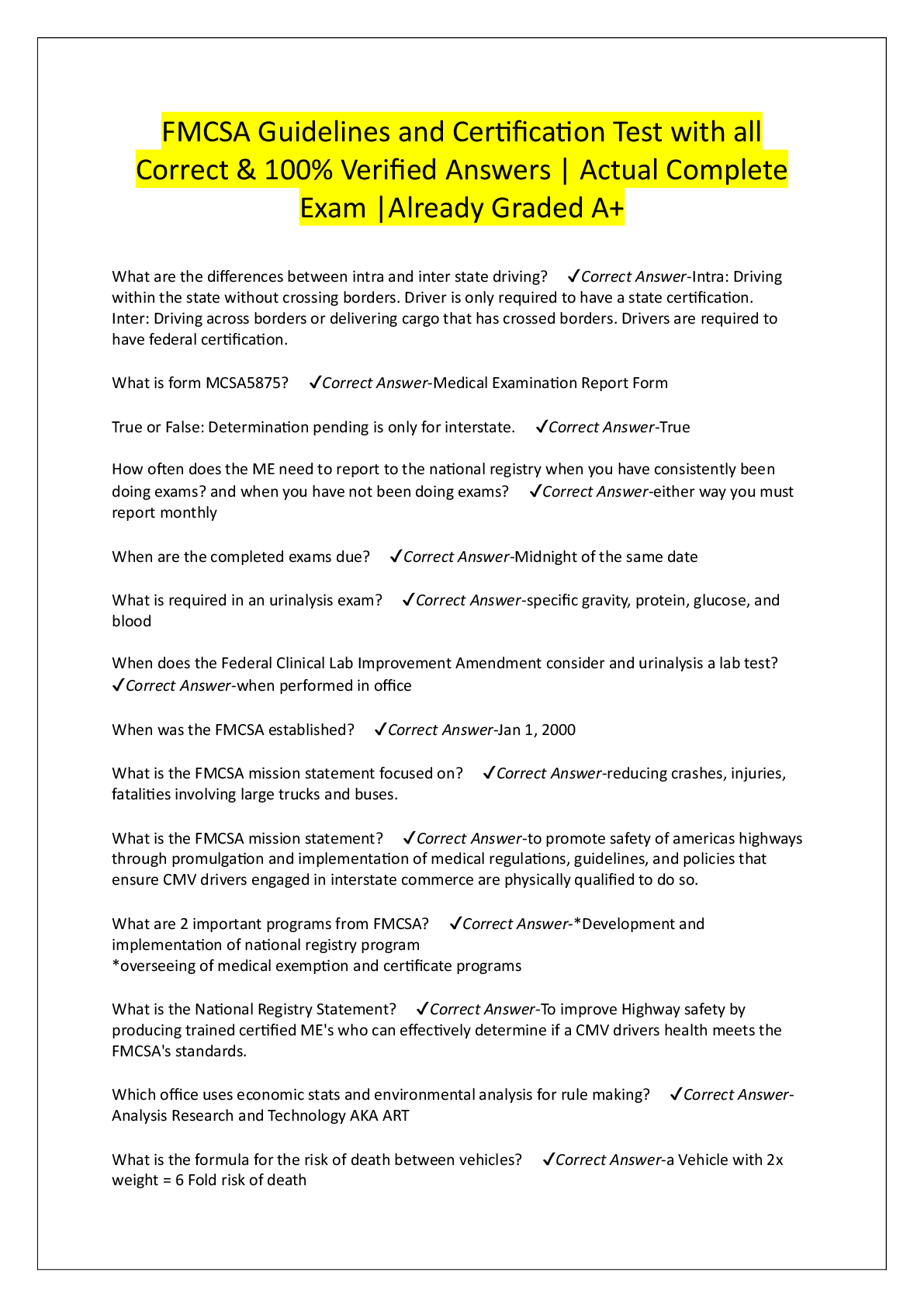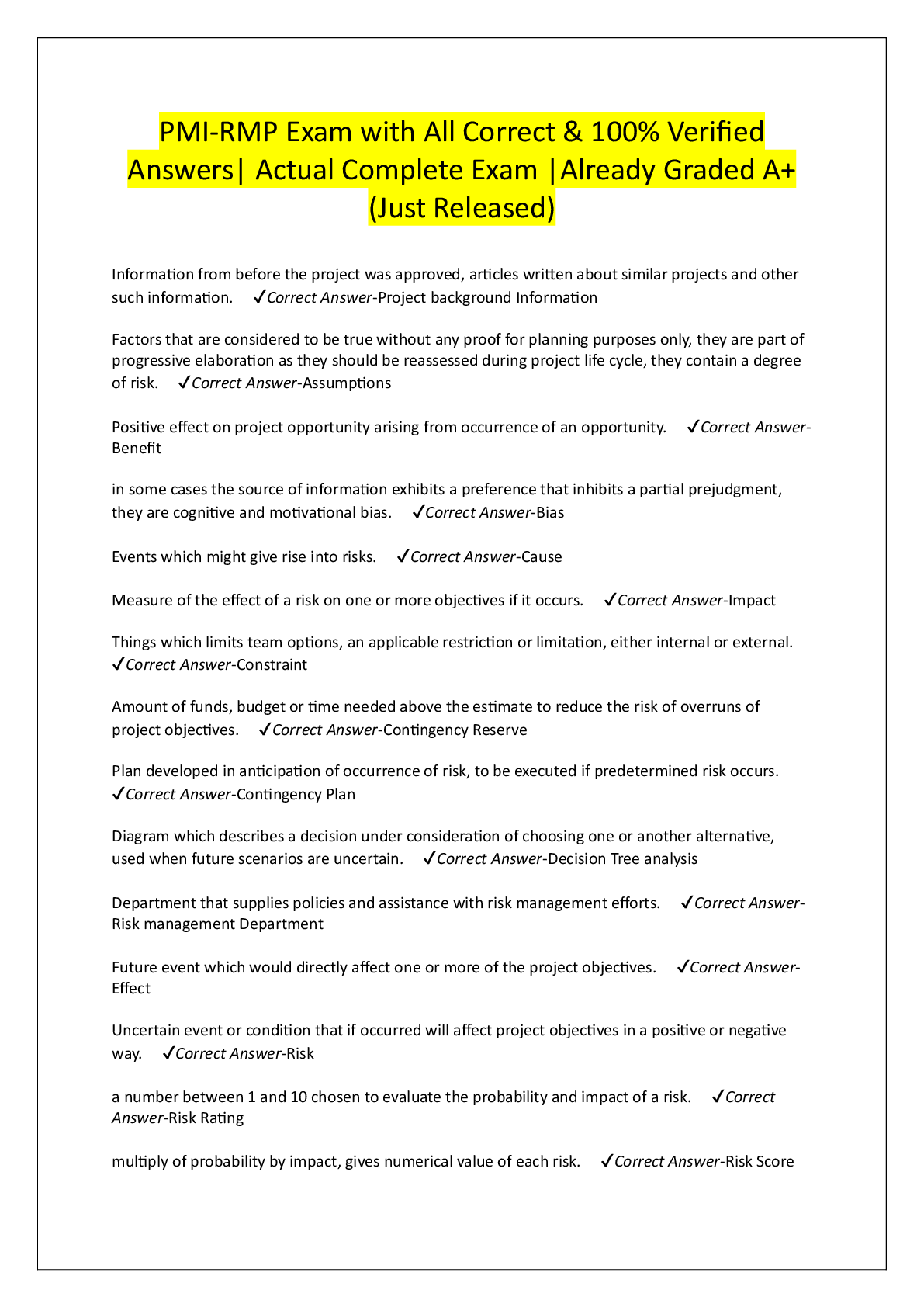BS 161 Exam 1 | Questions with 100% Correct Answers
Document Content and Description Below
BS 161 Exam 1 | Questions with 100% Correct Answers Where do lipids, a class of organic compounds, fit on the hierarchy of biological organization? DNA What are characteristics of an ionic bond? A
...
n electron is completely pulled from one atom to another. The electronegativity difference is always high between atoms of this bond type. What are characteristics of a covalent bond? Atoms of this bond might have equal electronegativities. This bond may also be polar or nonpolar. What are the 4 most common elements in living organisms? Carbon, Oxygen, Hydrogen and Nitrogen What elements are present in trace amounts only? Iodine and Zinc What elements are found in greater than trace amounts? Sodium, Chloride, Calcium, phosphorus, potassium, sulfur, magnesium and iron The atomic number of carbon-13 is ____ 6 The atomic mass of carbon-13 is ______ 13 C-12, C-13, and C-14 have the same number of protons but different numbers of neutrons so they are ______. Isotopes Atoms have gained or lost electrons and are no longer electrically neutral are called _____. Ions Describe a single covalent bond. Holds a molecule of hydrogen together, involves 2 atoms sharing 2 electrons and two chlorine atoms are held together by this bond. Describe an Ionic bond. Formed by an attraction between atoms with opposite charges, bond that hold NaCl together, Involves a transfer of one or more electrons from one atom to another, Leads to the formation of a crystal lattice rather than distinct molecules and Weakest type of bond shown. Describe a double covalent bond. hold a molecule of oxygen together, Involves 2 atoms sharing 4 electrons, strongest type of bond shown and carbon dioxide is held together by this type of bond. T/F A water molecule is held together by 2 single polar covalent bond TRUE T/F Because oxygen has a greater electronegativity than hydrogen, water molecules are polar w/ 2 partial negative charges near the oxygen atom and one partial positive charge near each hydrogen atom. TRUE T/F Atoms differ in their affinity for neutrons, a property called electronegativity. FALSE T/F In general, electronegativity increases from left to right across each row of the periodic table and also increases down each column. FALSE T/F In a nonpolar covalent bond there is an equal sharing of electrons between two atoms while polar covalent bonds involve an unequal sharing of electrons. TRUE T/F A single molecule of Oxygen is held together by 2 double non polar covalent bonds. FALSE T/F A covalent bond is formed when 2 atoms share one or more pairs of electrons TRUE T/F Polar molecules are electrically neutral but the distribution of charge within the molecule is not uniform. TRUE T/F Although C and H differ slightly in electronegativity, this small difference is negligible and C-H bonds are considered polar. FALSE T/F Of the 4 most common elements found in living organisms, nitrogen has the highest electronegativity and therefore, the greatest affinity for electrons. FALSE T/F A slightly positive hydrogen atom on one water molecule can attract the slightly negative oxygen atom on a different water molecule, leading to the formation of a hydrogen bond. TRUE What are properties of water? A wide variety of substances can move freely and interact within cells, the temp. of living organisms is relatively stable, evaporation of water is used to cool body surface, lakes freeze from top down, allowing fish and other life to survive below the surface and non polar molecules tend to aggregate or organize in ways that minimize their contact w water. As the pH scale increases the concentration becomes______. Greater pH's H+ concentration increases by ___. 10 When given electronegativity subtracting the difference between the two molecules will provide you with what information? If the atom is polar or nonpolar Monosaccharides create what polymer? Carbohydrates Nucleotides create what polymer? DNA Fatty acids, glycerol creates what polymer? Triglycerides Amino acids create what polymer? Protein Describe Dehydration synthesis A molecule of glycogen is formed by linking glucose molecules through this process, this process removes water to link 2 or more amino acids and monomers are linked together through this process Describe Denaturation. This process does not involve breaking of peptide bonds, but it does involve unfolding protein structure Describe Hydrolysis. Breaking DNA into nucleotides, adding water to break proteins into amino acids and the separation of polymers into smaller units Describe the primary structure. Amino acid sequence and it determines all other levels of protein structure Describe the secondary structure. Localized 3D structures and coil/sheet arising from chemical attractions among amino acids Describe Tertiary structure. The overall shaper of a chain of amino acids and it results when R groups move toward or away from water Describe the quaternary structure. Not all proteins have this level of organization and interactions between multiple chains of amino acids What might cause a protein to become nonfunctional? An increase in the pH of the surrounding solution, change in temp. near the protein, the surrounding decrease in pH of the surrounding solution, solutions shifts from water to oil, a change in amino acid sequence, decrease in salt concentration near protein and an increase in salt concentration near protein. What levels of protein would be affected if all hydrogen bonding interaction were prevented? Secondary, tertiary and quaternary What types of bonds link individual amino acids together? peptide bonds In the stable form of protein, what is generally oriented to the interior of the protein molecule? Hydrophobic portions A protein that has many hydrophobic R-groups pointing to the outside of the protein would be found... Embedded within a membrane When proteins are denatured, which type of bond is NOT disturbed? covalent bonds T/F If a proteins environment is altered, the protein may change its shape or even unfold completely, a process called dissociation. FALSE T/F Proteins can denature when the pH, temp. or ionic concentration of the surrounding solution changes TRUE T/F Denatured proteins are usually biologically active FALSE T/F When normal environmental conditions are reestablished after protein denaturation, almost all proteins can spontaneously refold back into their natural shape. FALSE T/F If the 3D structure of a protein spends only on its primary structure and the surrounding environmental conditions, then when the protein is denatured and subsequently returned to its native conditions it will spontaneously refold back into its native structure TRUE T/F Proteins have a narrow range of condition in which they fold properly; outside the range, proteins tend to renature. FALSE T/F Some proteins require other proteins called chaperones in order to correctly fold into their normal 3D shape TRUE T/F Cells use chaperones both to accomplish the original folding of some proteins and to restore the structure of incorrectly folded ones. TRUE T/F Some diseases may occur b/c a protein with the correct amino acid sequence fails to correctly fold into its final functional form. TRUE T/F During a process called dissociation, the polypeptides of a protein with quaternary structure separate and unfold, losing their individual tertiary structure. FALSE T/F The final 3D shape of a protein is determined entirely by its primary structure FALSE What qualities of a chemical reaction are affected by enzymes? The speed of reaction and the energy required to start the reaction What might happen if a substance that is not a substrate molecule binds to an enzyme's active site? Enzyme actively will slow down. An enzyme may catalyze a reaction by stressing or destabilizing the bonds of substrates. This point in the enzymatic reaction is known as the Transition state Sucrase uses _____ to cleave sucrose into 2 monosaccharides Water When it binds to sucrose, sucrase Goes through a conformational change What can you say about the change in free energy of the cleavage of sucrose into glucose and fructose? It is negative and the reaction is exergonic A mutation occurred in the gene that encodes the enzyme sucrase, resulting in a single amino acid substitution in the active site, of the enzyme whereby a polar amino acid changed to a nonpolar amino acid. The most likely result of this is Sucrase will not be able to bind to sucrose in the active site L-arabinose is naturally occurring, non-caloric sweetener that acts as a non-competitive inhibitor of the enzyme sucrase. If L-arabinose is consumed, what will happen to the hydrolysis of sucrose? Sucrose hydrolysis will be greatly reduced, since L-arabinose binding to sucrase will inactivate the enzyme. Your friend is studying a specific exergonic reaction. You friend hypothesizes that the addition of enzyme X will reduce the delta-G of this reaction, thus allowing it to proceed spontaneously. What do you think of this? Enzymes do not change delta-G, so this hypothesis does not fit with that is known about this reaction. What is the structure and function of the golgi apparatus? Stacked, flat, single-membrane sacs Creates vesicles to enclose materials to be secreted; produces lysosomes What is the structure and function of a ribosome? Two subunits of RNA and protein synthesized in the nucleolus of eukaryotic cells Location of protein synthesis What is the structure and function of the smooth ER? A single-membrane network Synthesizes lipids; detoxifies drugs and poisons What is the structure and function of the rough ER? A single-membrane network covered with ribosomes produces proteins destined for secretion from the cell What type of cells are in Smooth ER? intestinal cells that create new plasma membranes quickly, brain cells rich in lipids and testes that produce lipid storage What type of cells are in Rough ER? Pancreatic cells that secrete protein hormones and mucus secreting cells in the airway. Tay- Sachs disease causes lysosomes to rupture. How would this affect the cell? Phagocytic cells would not destroy bacteria, material taken up through endocytosis would not be digested and biological polymers would not be broken down by lysosomes The lysosome contains _____ enzyme Hydrolytic You are doing a study on the effects of lysosomal enzymes and want to follow the whole process from the formation of the enzymes to their use in the lysosome. In what location of the cell would you begin this observation? ER What functions do microtubules have? used to move vesicles within cells and made of dimers of alpha- and bea- tubulin What functions do actin have? Used to move cells and also called microfilaments What functions do intermediate filaments have? A strong structural protein within cells, no polymerization once formed and prevent excessive stretching of cells What are the functions of the cytoskeleton? To provides scaffolding for the enzymes in certain areas of the cell, organize cells activities, provide movement of molecules in the cell and provide the cell shape What are characteristics of desmosome? Destruction of intermediate filaments by cancers of epithelial tissues, adds strength in epithelial tissue of the top layer of the skin and allows flexibility when stretching. What characteristics of plasmodesmata? Penetrates the cell walls to allow a pathway for movement and allows flow of ions between two plant cells What characteristics of gap junction? Allows immediate communication between cells such as 2 neurons, allows types of smooth muscle and cardiac muscle to contract in unison. What characteristics of a tight junction? Resists the movement of material into and out of capillaries in the brain. holds together endothelial cells and seals epithelial cells to each other right beneath their surface on the top layer of skin. Suppose a researcher successfully produced a membrane composed of saturated triglycerides rather than from phospholipids. What characteristics would you expect the saturated triglyceride membrane to have? Hydrophobic molecules would be attracted to the membrane and the saturated triglycerides would not form a bilayer What do animal and plant cells have in common? Membrane is a bilayer of phospholipids, transport proteins embedded in membrane and they help the cell to maintain homeostasis T/F A triacylglycerol is composed of 3 glycerol molecules going to a fatty acid FALSE T/F The fatty acids of a triglyceride need to be identical, and often they are very different from one another TRUE T/F Glycerol is a 3-C alcohol, in which each carbon bears a carboxyl group FALSE T/F A fatty acid consists of a hydrocarbon chain joined to a hydroxyl group FALSE T/F The hydrocarbon chains of fatty acids vary in length as well as in the number and location of double bonds b/t the carbon atoms TRUE T/F Fatty acids with a one double bond in their hydrocarbon chain are called monounsaturated, while those with more than one double bond are called polyunsaturated TRUE T/F A saturated fatty acid has the maximum # of oxygen atoms bonded to its hydrocarbon chain FALSE T/F Fats containing unsaturated fatty acids have high melting points b/c their fatty acid chains bend at the double bonds, preventing them from packing closely together FALSE T/F Most plant fats contain saturated fatty acids and therefore liquid at room temperature. FALSE T/F Additional hydrogen atoms can be added to saturated fats, a process called hydrogenation FALSE T/F When unsaturated fats are partially hydrogenated industrially, this can produce trans fats which have been linked to elevated levels of how density lipoprotein (LDL) "bad cholesterol" and lowered levels of high-density lipoprotein (HDL) "good cholesterol" TRUE Fats are excellent energy storage molecules because: They have a relatively high ratio of energy storing C-H bonds What are some characteristics of phospholipids They contain a glycerol backbone, the phosphate head group is polar and the molecule is an important part of cell membranes How do membranes form spontaneously? The hydrophobic fatty acid tails on phospholipids are repelled by water. The protein Ras is involved in 25% of all cancers, and is attached to membranes through a covalent bond to a phospholipid. How does Ras associate with membranes? Through an anchor What are some properties of interior protein network? Helps determine the overall shape of a cell What are some properties of a phospholipid bilayer? Forms a semipermeable barrier and can allow diffusion of gases What are some properties of transmembrane protein? Can span both layers of a membrane and can form channels to allow small molecules to cross membranes What are some properties of cell surface markers? Often carbohydrates attached to a lipid or protein Larger _____ float within the bilayer Proteins Integral membrane proteins _________ in a membrane. Can move laterally In a phospholipid molecule, the "head is _____ Hydrophilic In a phospholipid molecule, the fatty acid "tails" are _____ Hydrophobic When phospholipid molecules are mixed with water, they can spontaneously organize into a bilayer with the "tails" located _______ of the bilayer. In the center
[Show More]
Last updated: 11 months ago
Preview 4 out of 17 pages
.png)














